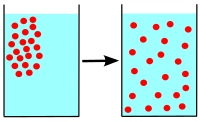
Photo from wikipedia
Abstract Diffusion of Xe atoms in UO2 fuel is important for nuclear fuel performance, and is enabled by interaction with U and O vacancies. Previous work using atomistic calculations based… Click to show full abstract
Abstract Diffusion of Xe atoms in UO2 fuel is important for nuclear fuel performance, and is enabled by interaction with U and O vacancies. Previous work using atomistic calculations based on density functional theory (DFT) and empirical potentials (EP) focused on the role of small vacancy clusters ( Xe U 2 O y , y = 0, 1, 2) for Xe transport, but the model predictions failed to reproduce the experimental observations by consistently underestimating Xe diffusivity. In this work, where we focused on out-of-pile conditions (i.e. in the absence of irradiation), we have explored two of the uncertainties associated with the model: the DFT methodology and the types of clusters considered. We found that using the energy barriers obtained with GGA + U DFT allows to reconcile simulation results and experimental observations in the intrinsic regime (i.e. out-of-pile conditions). The XeUO cluster is the preferred configuration at high temperature, while the mobile Xe U 2 O cluster takes over below 1720 K. The latter cluster is also the main contributor to Xe diffusion and good agreement is obtained with current models empirically fitted to experiments for diffusion at high temperature. A simple expression that captures most of Xe diffusivity is proposed, relying on XeUO and Xe U 2 O clusters only. We also determined the out-of-pile concentration and diffusivity of extended clusters Xe U x O y , 3 ≤ x ≤ 9 , and determined that these do not contribute significantly to the overall diffusivity under intrinsic conditions. However, we speculate that the Xe U 4 O 3 and Xe U 8 O 9 clusters, which have relatively low migration barrier, may play a role under irradiation conditions, because the radiation-induced enhanced vacancy concentration would rapidly increase the fraction of large Xe-vacancy clusters.
Journal Title: Journal of Nuclear Materials
Year Published: 2019
Link to full text (if available)
Share on Social Media: Sign Up to like & get
recommendations!